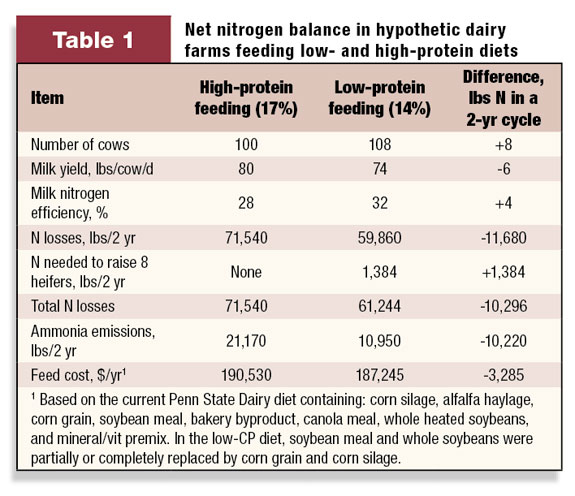Manure nutrients, a valuable commodity in the past, are becoming an unwanted pollutant. Manure is a natural “byproduct” of milk and meat production from farm animals. In human history, this “byproduct” has always been regarded as a highly valuable source of nutrients and was being applied back to the soil where the nutrients to feed animals originally came from.
In today’s agriculture, however, corn from the Midwest is shipped to the dairies in the West and manure, being regarded now as waste, does not come back to the corn fields of Iowa or Indiana.
As a result, areas with intensive animal agriculture have to dispose of an increasing amount of nutrients which the soil cannot accommodate, and crop uptake is insufficient to keep soil concentrations within acceptable limits.
The primary concern is with nitrogen and phosphorus which, through runoff and leaching of manure-amended soils, find their way into groundwater and surface water and cause eutrophication, a process leading to phytoplankton and zooplankton growth, oxygen depletion (hypoxia), and eventually loss of aquatic life.
These issues are particularly important in Pennsylvania, as the Susquehanna and Potomac River systems make up about 40 percent of the Chesapeake Bay watershed.
In the United States, farm animals are responsible for about 50 percent of anthropogenic ammonia emissions.
Ruminant animals are different from other farm/food animals in one important way – they have a rumen. The organ responsible for ruminants becoming the dominant species on the planet is also the reason for inefficient utilization of some dietary nutrients, specifically protein.
A high-producing dairy cow, for example, will excrete about 150 to 170 lbs of manure daily, which at about 17 percent dry matter will amount to 25 to 29 lbs dry manure.
If feed intake is about 60 lbs dry matter per day, this high-producing cow will digest from 52 to 59 percent of their feed, with the rest being excreted as manure.
On average, about 25 to 27 percent of nitrogen consumed by the cow is secreted in milk. This again, means that 75 percent are lost with manure. Nitrogen efficiency is even lower in feedlot cattle – only about 15 percent are retained as bodyweight gain.
There are two reasons for the inefficient use of nitrogen by ruminants: compared with pigs or poultry, lower-quality feeds with lower nitrogen digestibility (forages) are fed to cattle; and breakdown of high-quality protein in the rumen, which leads to nitrogen losses with urine when protein is overfed.
The efficiency of utilization of feed phosphorus, on the other hand, is generally higher in cattle because of the high concentration of indigestible phytate phosphorus in cereal grains and the lack of mammalian phytase enzymes.
Rumen bacteria produce phytases and the rumen ecosystem readily metabolizes phytate phosphorus. Supplementation of monogastric animal diets with synthetic phytases, however, to a large extent eliminates the problem in pigs and poultry.
An emerging issue with animal agriculture is manure ammonia emissions. In the U.S., farm animals are responsible for about 50 percent of anthropogenic ammonia emissions.
Ammonia has various implications in air and water quality, contributing to surface water eutrophication, soil acidity, aerosol formation and impaired visibility.
In the atmosphere, ammonia rapidly reacts with sulfuric and nitric acids to form sulfates and ammonium nitrate, which are considered fine particulate matter (PM2.5; particles with aerodynamic diameter of 2.5 microns or smaller).
These particles may cause an array of health problems – contributing to the risk of developing cardiovascular and respiratory diseases, as well as lung cancer.
Our estimates are that PM2.5 formed from ammonia emitted from livestock operations contribute on average from 9 to 11 percent of the total PM2.5 concentrations in the U.S.
The U.S. Environmental Protection Agency ruled on January 20, 2009, that animal feeding operations that did not endorse the 2005 USEPA Air Quality Compliance Agreement must notify emergency response officials if they emit 100 lbs or more of ammonia (or hydrogen sulfide) in a 24-hour period.
Animal feeding operations are exempt from reporting, under the Comprehensive Environmental Response, Compensation, and Liability Act, only for emissions from normal manure handling on farms; reporting is mandatory for other forms of release, such as from a burst anhydrous ammonia tank, breached lagoon or holding pond or manure spills.
Research trials have demonstrated that manipulation of livestock diets is among the most effective methods of reducing whole-farm nitrogen and phosphorus surpluses and ammonia emissions from manure.
Reducing dietary crude protein levels can have a dramatic impact on whole-farm nitrogen balance and ammonia volatilization losses from manure and manure-amended soil.
Our research has shown, for example, that decreasing dietary crude protein in dairy cow diets can result in up to 40 to 47 percent reduction in the ammonia-emitting potential of manure.
Manure from high-protein rations can emit as much as 50 percent more ammonia when applied to soil than manure from low-protein rations.
Proper implementation of low-nitrogen and low-phosphorus input feeding practices should have no negative impact on animal health or productivity and can enhance farm profitability through improved income-over-feed-cost ratios.
A number of Pennsylvania dairies participating in a Northeast SARE-funded project, for example, have switched to low-protein diets and have not seen negative impacts on milk production or composition.
In this age, pushing for maximum production regardless of how many nutrients are lost with manure is a questionable and unsustainable long-term strategy.
One may argue that loss of production necessitates raising more animals for maintaining milk supply, thus counteracting the benefits of reduced nutrient inputs per unit of product.
We did a simple calculation based on our research data and accepted agricultural standards. Assuming a worst-case scenario (which may or may not occur), a dairy cow may lose between six and seven lbs of milk with a low (14 percent) vs. high (17 percent) crude protein diet.
In this case, a 100-cow herd will have to have eight additional cows to make the same amount of milk. These cows have to be raised, which will also require additional input of nutrients into the production system.

Even in this worst-case scenario, however, as Table 1 shows, the farm will still be producing about 10,300 lbs per two-year cycle (required to raise the heifers) of nitrogen less with the low-protein than with the high-protein diet.
In addition, ammonia losses from manure will be about 10,200 lbs per two-year cycle less with the low-protein feeding system. Last but not least, the farm may also save about $3,000 per year in feed cost.
Thus, it is apparent that efficiency and sustainability of a dairy operation may be environmentally and economically more responsible than maximizing milk production. PD
References omitted due to space but are available upon request to editor@progressivedairy.com.
—Excerpts from Penn State Dairy Digest December 2010.
Alexander Hristov is an asssociate professorof dairy nutrition withPenn State University. Email Alexander Hristov.






